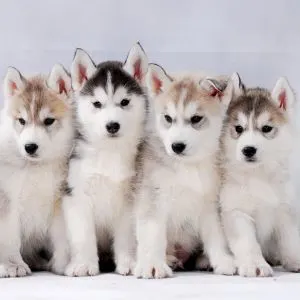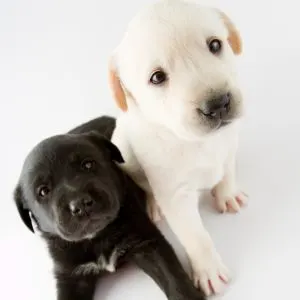Updated 11/27/2023: When you Pick a puppy from a litter it can be an exciting yet daunting experience, especially if you’re first-time dog owners.
At first glance, they might all look and act the same, scampering around and being their adorable selves. But don’t let their cuteness overload fool you. Each one of these little guys has a unique personality and set of traits.
Resist the urge to pick the first puppy that comes bounding over to you or the one with the fluffiest tail. It’s not just about looks or first impressions. It’s about finding a healthy puppy that is a good fit for your lifestyle.
When you’re looking to bring a new puppy into your home, the key is to start by finding a reputable breeder. This step is super important because a good breeder not only ensures the puppies are healthy, but they also care about their temperament and how they’re raised.
You’ll want to look for someone who’s open about their breeding practices and happy to answer all your questions. Think of it as a bit of detective work to ensure you’re adopting a puppy from a place where they’re not only loved but also well-prepared for their new homes.
To help guide you through this process, we’ve gathered some of the best tips for choosing the right puppy from a litter. These tips will focus on assessing the puppies’ interactions with their littermates, and on their own, to help you make an informed decision.

Of course, breeders are not the only place where you can pick a puppy. You may also be able to pick a puppy from a litter at a rescue or local shelter. In this case the process will be similar, but a bit different. We will discuss this at the end of the post.
Pick a Puppy from a Breeder
When Can You Pick A Puppy?
A responsible breeder will allow future puppy parents to pick their puppy at 8 weeks of age when the puppies are ready to go to their new home. This timing is important because, by then, the puppies are usually weaned from their mother, have started developing their personalities, and have begun socializing with their litter mates and humans.
Pick of the Litter
Many breeders will reserve the right to pick a puppy from the litter for themselves before anyone else has the chance to pick. Typically these puppies will be used as part of the future breeding program. These puppies are often referred to as the pick of the litter.

How are Puppies Picked
There are two ways that puppies can be “picked” when you get them from a breeder.
- The breeder picks the puppy for you based on:
- What they know about you
- Their knowledge of the other families getting a puppy
- Observing of the puppies
- Their expertise as a breeder
- You are allowed to pick your own puppy with some guidance from the breeder.
Breeder Picks
If the breeder chooses a puppy, you want to make sure they have as much information about you as possible. Make sure to tell them about yourself, your lifestyle and your expectations of your new puppy. This will enable them to make the best match possible.
The breeder should be asking you important questions like:
- What kind of puppy are you looking for?
- If you have kids?
- Are you home during the day?
- Do you want a male dog or a female dog?
- Are you an active person?
- What activities are you looking to do with your pet?
- Are you looking for a hunting dog?
- If you are getting a poodle mix do you have a preferred hair type
- Are you looking for an energetic or calm pup?
- Do you want them to be independent or eager to please?

You Pick
If you are allowed to pick a puppy from the litter, you need to know where you are in the picking order. If you were the last person to send in a deposit you will not have an option to choose. You will simply be given the remaining puppy after everyone else has made their picks.
If you get to pick a puppy from the entire litter take some time to think about what you are looking for in an adult dog. Use the questions above to help you determine what your needs are. Then discuss what you are looking for with the breeder and let them guide you to the pup that best fits you.
Your breeder should be spending time with the puppies as they grow. During this time an experienced breeder will get to know the puppy’s individual personalities and traits. By the time the puppies are ready to be picked, the breeder should have a good idea of what each puppy’s temperament will be like as an adult.
It is in the best interest of your breeder to make sure you go home with the right choice for you.

How to Pick a Puppy from a Litter
Regardless of where you get your puppy from, the process to pick a puppy from a litter is the same.
- Bring a friend
- Observe the litter
- Pick a few pups to meet individually
- Evaluation each puppy individually using:
- Cradle Test
- Touch Sensitivity Test
- Summons Test
- Sound Sensitivity Test
- Vision Test
- Visual check
- Bite Response
Bring a friend
When planning to pick a puppy from a litter, ask an impartial friend or family member to come along. Seeing all those cute, happy faces can be overwhelming, so it helps to have someone evaluate the pups with you.
Observe the litter
Ask if you can observe the entire litter for a few minutes. Once you ensure that all the puppies are there, pay attention to how the puppies interact with each other. Try to figure out which pup is dominant and which one (if any) is the shy puppy.
If you are having a hard time figuring it out, casually ask the breeder/foster mom what she thinks. Both of these types of pups can come with training issues as they mature.
You want to pick from a litter of puppies that are friendly, curious, and trusting around their siblings and you. They should be exhibiting signs of interest and trust like smelling your feet and legs, crawling on you and looking for attention.
Look for signs of fear like running away or refusing to get close. This may be an indication that they will need extra training to become properly socialized. It’s alright if they lose interest in you and start playing with each other.

Personality Types
There are several distinct personality types in puppies. Look for the following signs to discover each puppy’s personality:
The Dominant Pup
A dominant pup may seem friendly, social and active, but you may notice them stealing toys from other pups, climbing over their litter mates, playing rough or trying to break out of their enclosure. These are signs of wanting to be in control and may lead to them being harder to train. They may also try to challenge young children. If you have young children this may not be a good fit.
The Independent Pup
An independent pup likes to make their own choices. You may find them doing their own thing. This pup can be quick-thinking, fun loving and engaging but they can also be hard to train. Often, they have their own agendas and are not interested in your commands. These pups will require a lot of training but may become bored with repetitive training. Independent pups tend to have unique and fun personalities though.

The People Pleaser
The people pleaser wants to be with people and will come looking for your attention. These pups can become very attached to their owners. With good positive training these pups can make great family companions. They will not be a good choice for a home where they are often left alone.
The Relaxed Pup
The relaxed pup may be less interested in you than their siblings. It is sometimes believed that a relaxed pup is less intelligent, but they will balance play, interaction and sleep, well. They will be a great fit for relaxed owners and a family. Make sure you don’t confuse a relaxed pup with a shy puppy. A relaxed pup will still be friendly, but a shy pup will keep their distance.

The Shy Pup
The shy pup will be timid when compared to their litter mates. They may keep their distance from you, wait in the back of the pack or hang their head low. A shy pup will need a lot of time and patience to foster their self-esteem so that they become comfortable around others. They are more suitable for singles and couples who have time to train them and give them a lot of attention.

Evaluate Puppies Individually
Once you have had a chance to evaluate the pups with their litter, the next step is to meet the available pups one on one out of sight from the rest of the litter. Try to conduct the following evaluations on each puppy.
Cradle Test
Carefully pick up the puppy. Cradle them in your arms and see how they react. Does the pup struggle? Is she trying to mouth or bite? Does he lick your face? Is he calm? A puppy that puts up a struggle at first but then settles down might be easier to train than a puppy that does not want to be held.
Touch Sensitivity Test
Holding the puppy, touch his toes and squeeze gently on his paws. Touch the pup’s ears, and face too. Pups that yelp at the slightest pressure or bite your hands are not good for families with kids. A good sign is a pup that shows no response.
Summons Test
Sit or kneel on the ground and call the puppy to you. Click your tongue or tap the ground to get the puppy’s attention if he does not respond to his name. If he comes to you quickly, he may have a strong attachment to people. If he ignores you or gets distracted he may be independent and require an experienced trainer.
Sound Sensitivity Test
Either clap your hands behind the pup’s head or drop a set of keys on the floor near the puppy but where they cannot see it fall to see what their reaction is. Does he ignore it? Does he get startled by it? A good response for a puppy is to go investigate the source of the sound.

Vision Test
To check a pup’s vision, roll a ball within the pup’s field of vision and see if he reacts to it by watching it or playing with it.
Visual check
Take a good look at each puppy. Puppies should be nice and round, not too fat and not too skinny. Their eyes should be clear, bright and with no crust or discharge. Their ears, nose and teeth should be clean and gums pink.
Puppies should also have clean shiny coats with no sign of dirt or debris on their bodies. Listen to how the puppy is breathing. It should be quiet without coughing or sneezing a lot.
Watch the Puppies
Watch how the puppy walks and runs. The puppy should be able to move around without limping or seeming stiff or sore. Trouble moving may indicate hip or joint issues that could develop into something worse.
Pay attention to their energy level. If a pup bounces off the walls where he is, he’ll probably do it at your home. This puppy will be good for a very active home that will include him in the activities.
Bite Response
To test a puppy’s bite response, allow the puppy to mouth you until they start to bite. At that point respond with a high pitched “Ouch!” Watch to see if the pup catches on to your pain response. They should react with fear or concern, rather than excitement.
Puppies that stop biting when people or dogs show pain are more likely to develop into adult dogs with good control over their mouths. Don’t be too concerned if the puppy notes your reaction, stops for a moment, and then returns to nibbling your fingers. This is normal.

Picking the right dog for you
Now that you have had a chance to look at each individual puppy, it’s time to decide. Think about your own personality and try to decide which puppy is the best fit for your home environment. Just remember that you are picking out your new best friend.
Picking a Puppy from a Rescue
Picking a puppy from a litter at a rescue group is a lot like picking a puppy from a breeder. If you are the first person to be approved for adoption you may be allowed to pick from the entire litter, otherwise you will get to pick based on when you are approved. But just like with breeders, some rescue groups prefer to do the picking.
If this is the case make sure to tell them about your lifestyle and what you are looking for so they can make the best possible match.
Still looking for a rescue pup? Check out our rescue posts.
Picking a Puppy from a Shelter
Most government run shelters use a first come, first serve approach to dog adoptions. Meaning if they have a litter of puppies you will be given the option to meet all the puppies that are still available.
What you need to do before bringing home a puppy
- Make sure your home is safe. In Puppy Proofing Your Home – 10 Silent Dangers we go over many of the common household hazards you need to watch out for.
- Gather what you need for your new puppy. Join us at “What You Need for a New Puppy” to learn about the essential items you need before you bring your puppy home.
- Decide if crate training is right for you. Crate training not only provides a quiet place for your pup to retreat to when they are scared, tired or over stimulated. It also keeps your puppy safe and out of trouble when you can’t keep an eye on them. To learn more about crate training read Crate Training -Made Easy and Puppy Crying in the Crate at Night? How to Help Them Sleep
Bringing Home Your Puppy
As you get ready to bring your new puppy home, it’s time to think about the key questions to ask your breeder. These questions should cover the puppy’s health history, its daily routine including feeding and sleeping schedules, and any other details that will aid in a smooth transition for your new pet. For a helpful guide on what to ask, check out our post 30 Questions To Ask A Breeder When Picking Up A Puppy.
What to do next
Give them a name
Once you have selected your puppy you need to give them a name. To help we have put together a few naming guides to help you to choose.
- Unique Dog Names: Plus How to Pick One
- Scottish Dog Names: 500 Names to Choose From
- Australian Dog Names: 200 Dog Names to Choose From
- Norse Dog Names: Viking Names for Your Dog
- 550 British Dog Names: You Will Want to Use
- French Dog Names For Your Doodle
- Flower Names For Dogs: Plus Nature Inspired Dog Names
It Is Up To You
Picking the perfect puppy is only the beginning. How a puppy is raised will determine how they turn out. Make sure you understand what it means to properly socialize a puppy and make every effort to do it well.
Check out these posts to learn more about puppy socialization:
- How to Socialize A Puppy – Made Easy
- 10 Puppy Socialization Mistakes to Avoid
- 5 Safe and Easy Ways to Socialize Your Puppy.
How to Pick a Puppy From a litter Resources
- Choosing the Right Puppy from a Litter by By Lynn Buzhardt, DVM

Jana Rade
Monday 1st of June 2020
The only way I can pick a puppy under any circumstances is when they show me only a single one. LOL
Bonnie
Tuesday 2nd of June 2020
I am the same way. When we picked up Bella we tried to convince them to give us her sister too but they wouldn't.
Katie
Monday 1st of June 2020
This is an awesome post! Picking a puppy can be stressful, and anything that helps alleviate that stress is appreciated. We’ve also rescued both our pups, so we had time to do a meet and greet with them prior to welcoming them into our home.
Bonnie
Monday 1st of June 2020
Thanks! It is great that you were able to meet the rescue pups prior to adoption. As you mentioned it can be quite stressful to try to decide which one is the right one for you in a short amount of time. If helps to have some objective way to evaluate them. Hopefully this post will help people who are looking for their furry best friend.
Emilia
Monday 1st of June 2020
Excellent list. I’ve not had to choose up to now - the right furballs have always be obvious, but I’m on a couple lists right now for a dream kitten. Since the breeders are friends I might let them pick for me as I would be overwhelmed. Unless one stands out. I’m looking to show so I feel the breeder would have a better idea of what cat would do better. I think I’m thankful there’s still going to be time for my turn to come up.
Bonnie
Monday 1st of June 2020
Congratulations on your future new kitty. Allowing your breeder who is a friend, pick your kitten is a very sound idea. Quailty breeders will have your best interest in mind. Plus they have spent the last 8 weeks getting to know the kittens.
Good luck in the shows!
Robin
Monday 1st of June 2020
Excellent tips! Choosing a puppy (or a kitten) is an exciting time, but also one where you have to make sober judgments. I hadn't thought about a touch sensitivity test. That is a great idea! If you can, it is good to know how well the dog will respond to being touched.
Bonnie
Monday 1st of June 2020
Thanks! As you pointed out many of these suggestions can be used on kittens too.
Rebecca Sanchez
Monday 1st of June 2020
Absolutely love the cradle test it really can help you decide which puppy to get. We did the cradle test with our first dog that we adopted, and it was amazing and he just rolled on his back and was so comfortable. That made a huge difference in his ability to learn and adapt and grow.
Bonnie
Monday 1st of June 2020
Many of the tests we suggest people use to identify a puppies personality can also be used on an older dog. Assuming they are small enough to sit in your lab. ;) We once adopted a 7 year old 112 pound Golden Retriever. We could have really used the cradle test to know what we were getting into, but he was way to big. I have learned a lot about dogs since then.